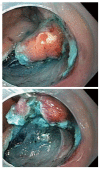Magnetic anchor guidance for endoscopic submucosal dissection and other endoscopic procedures
- PMID: 28522906
- PMCID: PMC5413783
- DOI: 10.3748/wjg.v23.i16.2883
Magnetic anchor guidance for endoscopic submucosal dissection and other endoscopic procedures
Abstract
Endoscopic submucosal dissection (ESD) is a well-established, minimally invasive treatment for superficial neoplasms of the gastrointestinal tract. The universal adoption of ESD has been limited by its slow learning curve, long procedure times, and high risk of complications. One technical challenge is the lack of a second hand that can provide traction, as in conventional surgery. Reliable tissue retraction that exposes the submucosal plane of dissection would allow for safer and more efficient dissection. Magnetic anchor guided endoscopic submucosal dissection (MAG-ESD) has potential benefits compared to other current traction methods. MAG-ESD offers dynamic tissue retraction independent of the endoscope mimicking a surgeon's "second hand". Two types of magnets can be used: electromagnets and permanent magnets. In this article we review the MAG-ESD technology, published work and studies of magnets in ESD. We also review the use of magnetic anchor guidance systems in natural orifice transluminal endoscopic surgery and the idea of magnetic non-contact retraction using surface ferromagentization. We discuss the current limitations, the future potential of MAG-ESD and the developments needed for adoption of this technology.
Keywords: Endoscopic submucosal dissection; Esophageal cancer; Gastric cancer; Magnetic anchor guidance; Magnets; Natural orifice transluminal endoscopic surgery; Traction.
Conflict of interest statement
Conflict-of-interest statement: All authors have no conflicts-of-interest.
Figures


Similar articles
-
Magnetic anchor-guided endoscopic submucosal dissection for colorectal tumors (with video).Surg Endosc. 2020 Feb;34(2):1012-1018. doi: 10.1007/s00464-019-07127-9. Epub 2019 Sep 30. Surg Endosc. 2020. PMID: 31571035 Clinical Trial.
-
Prospective clinical trial of magnetic-anchor-guided endoscopic submucosal dissection for large early gastric cancer (with videos).Gastrointest Endosc. 2009 Jan;69(1):10-5. doi: 10.1016/j.gie.2008.03.1127. Epub 2008 Jul 2. Gastrointest Endosc. 2009. PMID: 18599053 Clinical Trial.
-
Experimental study of magnetic hydrogel assisted magnetic anchorguided endoscopic submucosal dissection in colonic tumors.Technol Health Care. 2024;32(6):4505-4514. doi: 10.3233/THC-240653. Technol Health Care. 2024. PMID: 39302395 Free PMC article.
-
Short-term outcomes of traction-assisted versus conventional endoscopic submucosal dissection for superficial gastrointestinal neoplasms: a systematic review and meta-analysis of randomized controlled studies.World J Surg Oncol. 2019 Jun 4;17(1):94. doi: 10.1186/s12957-019-1639-z. World J Surg Oncol. 2019. PMID: 31164139 Free PMC article.
-
Recent traction methods for endoscopic submucosal dissection.World J Gastroenterol. 2016 Jul 14;22(26):5917-26. doi: 10.3748/wjg.v22.i26.5917. World J Gastroenterol. 2016. PMID: 27468186 Free PMC article. Review.
Cited by
-
Development and validation of a predictive model for submucosal fibrosis in patients with early gastric cancer undergoing endoscopic submucosal dissection: experience from a large tertiary center.Ann Med. 2024 Dec;56(1):2391536. doi: 10.1080/07853890.2024.2391536. Epub 2024 Aug 16. Ann Med. 2024. PMID: 39149760 Free PMC article.
-
Magnetic anchoring and guidance-assisted endoscopic irreversible electroporation for gastric mucosal ablation: a preclinical study in canine model.Surg Endosc. 2021 Oct;35(10):5665-5674. doi: 10.1007/s00464-020-08245-5. Epub 2021 Jan 8. Surg Endosc. 2021. PMID: 33420599
-
Endoscopic diagnosis and treatment of gastric dysplasia and early cancer: Current evidence and what the future may hold.World J Gastroenterol. 2021 Aug 21;27(31):5126-5151. doi: 10.3748/wjg.v27.i31.5126. World J Gastroenterol. 2021. PMID: 34497440 Free PMC article. Review.
-
ESD and Pit Pattern Diagnosis: Lessons from a Japanese Endoscopist Working in the United States.Clin Colon Rectal Surg. 2020 Nov;33(6):329-334. doi: 10.1055/s-0040-1714235. Epub 2020 Sep 4. Clin Colon Rectal Surg. 2020. PMID: 33162836 Free PMC article. Review.
-
Methods that Assist Traction during Endoscopic Submucosal Dissection of Superficial Gastrointestinal Cancers: A Systematic Literature Review.Clin Endosc. 2020 May;53(3):286-301. doi: 10.5946/ce.2019.147. Epub 2020 Jan 9. Clin Endosc. 2020. PMID: 31914722 Free PMC article. Review.
References
-
- Saito Y, Kawano H, Takeuchi Y, Ohata K, Oka S, Hotta K, Okamoto K, Homma K, Uraoka T, Hisabe T, et al. Current status of colorectal endoscopic submucosal dissection in Japan and other Asian countries: progressing towards technical standardization. Dig Endosc. 2012;24 Suppl 1:67–72. doi: 10.1111/j.1443-1661.2012.01282.x. - DOI - PubMed
Publication types
MeSH terms
LinkOut - more resources
Full Text Sources
Other Literature Sources
Research Materials
Miscellaneous

